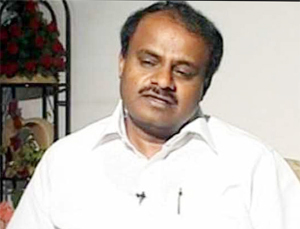HDK to release his own report on B’luru lakes
Mangalore Today News Network
Bengaluru, May 15, 2015 DHNS: JD(S) leader H D Kumaraswamy on Thursday charged the Siddaramaiah government with protecting the residents of posh layouts illegally created by BDA and challenged the government to demolish structures in these layouts too. He hinted that he had no confidence in the report to be submitted by the House Committee headed by K B Koliwad on lake protection, as the government was “bound to influence” the contents of the report. He said that he would, in turn, furnish a detailed report on the lakes in Bengaluru. Kumaraswamy is one of the members of the committee.
He hinted that he had no confidence in the report to be submitted by the House Committee headed by K B Koliwad on lake protection, as the government was “bound to influence” the contents of the report. He said that he would, in turn, furnish a detailed report on the lakes in Bengaluru. Kumaraswamy is one of the members of the committee.
Interacting with reporters here, Kumaraswamy said that the government was exhibiting double standards by trying to regularise the illegal layouts.
‘Poor victimised’
Mocking Chief Minister Siddaramaiah for calling himself an ‘Ahinda’ leader, he wondered why it was that the government had victimised only the poor by demolishing their houses, during the drive to clear encroachments on lake beds.
“Are the residents of 50x80 sites in these posh layouts poor? Are they vegetable vendors or downtrodden, for the chief minister to be protecting them? Scores of dalit, backward classes and minority community people have been pushed to the streets during the demolition drive. How can Siddaramaiah call himself an Ahinda leader? Why is that there is differential treatment between the haves and the have nots? Let the government demolish properties in the posh layouts too and rehabilitate the house owners under the Ashraya scheme,” he said.
The former chief minister said that as member of the committee, he had asked it to recommend to the government to resume the demolition drive after the members submitted the report.
He said that he had convened a public meeting on Sunday to discuss the various aspects of the issue, and invited retired officers including Siddaiah, Jaiker Jerome, K Jairaj, former Lokayukta Santosh Hegde and freedom fighter H S Doreswamy to participate.
5,000-page report
He said that he was working on a 5,000-page report on the lakes of Bengaluru, which would include information pertaining to water bodies, 1932 onwards.
He said that he was investing six to seven hours every day to prepare the report, which he said would be made public in the next few months. The report would be uploaded on a website.
- Two booked for abusing, misbehaving with doctor on duty at hospital in Puttur
- Udupi-Bengaluru private bus catches fire in Mandya; passengers safe
- Vittal: Decomposed body of Paltaje resident found in isolated spot
- We are in favor of peace, Union Govt must strengthen security measures says Siddaramaiah
- 3 Pak women residing in City Police Commissionerate limits
- All-religion meet pays homage to late Pope Francis
- Pahalgam attack: DK Congress holds candle light vigil
- Tirthahalli student Deeksha scores 600/600 in II PU after revaluation, tops science stream in Karnataka
- Kudremukh trekking circuits to reopen from May 1
- Two medical students of Tiruchi SRM Medical College drown in Arabian Sea at Gokarna
- KS Hegde Hospital achieves landmark success with three complex Carinal Resection Surgeries for lung cancer
- Mangaluru: Facebook page booked for supporting Pahalgam massacre; probe underway to trace admin
- Nitte Institute of Hospitality Services: 33 years of excellence in shaping hospitality professionals
- 280 injured, several feared dead after explosion tears through Iran’s Bandar Abbas port
- Two ATM robbers shot at in Kalaburagi
- Blood will flow if India stops river water, Bilawal Bhutto threatens
- Not a drop of water to Pakistan, says Jal Shakti Minister
- Ranya Rao charged under anti-smuggling law, to be detained for year: Sources
- Houses of 5 terrorists across J&K razed days after Pahalgam attack
- Strong message from UN Security Council after Pahalgam terror attack
- Pakistan continues unprovoked firing along LoC; Indian Army responds
- Kashmir on high alert after intel warns of terror plots targeting non-locals, rail network
- Supreme Court pulls up Rahul Gandhi over Savarkar remark, stays HC order
- Former ISRO chief K Kasturirangan passes away in Bengaluru
- Identify all Pakistanis in India, send them back: Amit Shah to Chief Ministers
- Skills and Competencies Take Center Stage at MSN Dialogue Series
- Court remands Maoist Lakshmi to six-day police custody
- Sandhya Shenoy honored with Society for Materials Chemistry Medal-2024
- White Cornus Apartment in Mangaluru
- City girl wins first place in state-level spell bee competition
- Alleged ‘Love Jihad’ Case in Mangaluru: Woman left home voluntarily, says police
- Girl fatally struck by reckless two-wheeler near Belman
- New residential complex for the judges inaugurated in Mangaluru
- Absconding accused nabbed after 8 years
- Truck with cylinders turns turtle in Beltangady
- Bhoota Kola artist dies of cardiac arrest
- Development of the country should be our goal: Ganesh Karnik
- Container truck gets stuck under Modankap railway bridge
- Truck crushes bike’s pillion rider near BC Road
- Head constable dies of heart attack
- CITY INFORMATION
- TRAVEL
- TOURIST INFORMATION
- HEALTH CARE
- MISCELLANEOUS




 Write Comment
Write Comment E-Mail To a Friend
E-Mail To a Friend Facebook
Facebook Twitter
Twitter  Print
Print 


